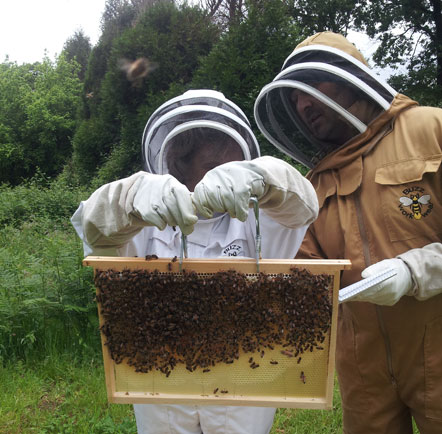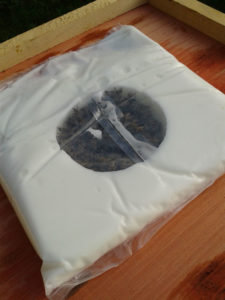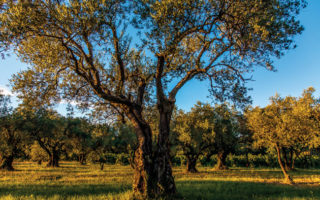Beekeeping in the Charente – Treats and Treatments

Not many people think of South West France as being anything other than swathed in sunshine, with maybe a warm breeze making the heat bearable, but the truth is that January in the Charente can be bitterly cold. It’s still sunny, but frosty with it! We’re all accustomed to feeding the garden birds by putting out fat-balls and bread crusts, and maybe some meal worms or cat food for hedgehogs, but here at ‘13 Bees’ we are busy providing our hives with blocks of fondant icing. Everyone thinks a beekeeper can take it easy in winter; after all, aren’t the bees hibernating? Well, yes, in a way, but you’d be surprised at how much there is to do. From ensuring we have enough clean equipment, to caring for our colonies, we certainly can’t just put our feet up.
 A few months ago we raided our five hives for the delicious honey that the bees had spent all summer making, so now it’s only fair that we supplement their remaining winter stores with plenty of lovely sugar. In the autumn and spring we can give them a boost by providing sugar syrup, a weak mixture of sugar in water, but when the temperature drops below freezing they need a fast, direct hit of energy, so the concentrated sugar in fondant is what they get. Luckily for our bees, Kevin my husband doesn’t like royal icing on fruit cake, so this year I put it in the hives instead! Traditionally the fondant is put in the hives on Boxing Day, as a Christmas treat for the bees, and our colonies certainly seem to appreciate it.
A few months ago we raided our five hives for the delicious honey that the bees had spent all summer making, so now it’s only fair that we supplement their remaining winter stores with plenty of lovely sugar. In the autumn and spring we can give them a boost by providing sugar syrup, a weak mixture of sugar in water, but when the temperature drops below freezing they need a fast, direct hit of energy, so the concentrated sugar in fondant is what they get. Luckily for our bees, Kevin my husband doesn’t like royal icing on fruit cake, so this year I put it in the hives instead! Traditionally the fondant is put in the hives on Boxing Day, as a Christmas treat for the bees, and our colonies certainly seem to appreciate it.
At this time of year there aren’t many bees in each hive, around 5,000 or so compared to the 90,000 there are at the height of summer, and they spend these quiet months clustered together in the centre of the hive. The honey is stored around them, safely ensconced beneath pure wax cappings, and we place the extra food, the fondant, above these stores. The bees can sense the sugar and collect it, storing it in turn in the cells close to the cluster. During the cold winter months the queen usually stops laying eggs, reducing the need for the bees to find food to nourish growing larvae. However, it won’t be long before the Spring warmth triggers the queen into laying again, and the population of each hive will grow rapidly – the stored sugar will be needed to feed all those extra hungry mouths, especially if a wet Spring means the bees can’t fly out to forage. Many sorry tales abound of bees surviving the winter only to starve to death in February, another reason why we give our bees their Christmas treat.
One of the biggest threats to honeybee colonies is a parasite known as varroa destructor, a blood-sucking mite that breeds in sealed bee brood cells, developing with the larvae and triggering serious viruses. There are various treatments that can be given to bees, of varying efficacy, but one of the best, killing almost all varroa in a hive, is oxalic acid, and this is the best time of year to administer it. This is because the queen is not normally laying eggs, therefore there are no developing larvae, which means all the varroa are already out on adult bees.
The oxalic acid can either be trickled down the wax frames, or sublimated by warming up crystals so that they turn into a vapour that then drifts through the hive. This is thought to be the best delivery method as you can be sure that all the bees come into contact with the treatment. The vapour kills the varroa without harming the bees, and as it cools it turns back into crystals which are then cleaned out by the bees. As there are no larvae in the hive on which the varroa mites can hide, this treatment can clear a hive of this terrible pest.
Oxalic acid is extremely dangerous to humans; it’s used to remove rust from engines so you can imagine what it would do to lungs, but handled responsibly it is just what a varroa-infested hive needs. Hopefully we will be able to treat all our hives later this month and will start this beekeeping year as strong and healthy as possible.
Amanda and Kevin moved to Confolens (16) in 2015, opening a chambre d’hôte and launching their beekeeping experience holiday business. They live with five cats, two tortoises and several thousand bees, and enjoy sharing their adventures in the apiary with others.
Share to: Facebook Twitter LinkedIn Email
Leave a reply
Your email address will not be published. Required fields are marked *



